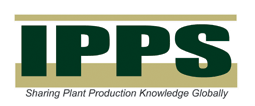|
Vol. 43
Title:
Disease Control in the Propagating House
Author:
Ralph S. Byther
pp: 205-207
Abstract:
To understand strategies for disease control in propagating houses, it is necessary to understand some basic concepts of how diseases develop. Three components must be present before a disease will occur: (1) a pathogen (micro-organism that is capable of causing disease), (2) a susceptible host plant, and (3) favorable environmental conditions for the disease to develop. In addition, all three must be present for a sufficient length of time to allow infection to take place. If any of these components is lacking, no disease will develop If these components are present at a less than an optimum level, disease will develop at a slower rate.
Because of the environmental conditions in a propagating house, the potential for disease is very high. Free moisture, high humidity, and mild temperatures favor the development of many fungal and bacterial diseases Propagation houses could almost be considered by a pathologist to be an ideal inoculation chamber to study diseases. The vast majority of
Full text:
IPPS members
ISHS members & pay-per-view
(PDF 234028 bytes)
Translate:
   IPPS membership administration
ISHS membership administration
|



